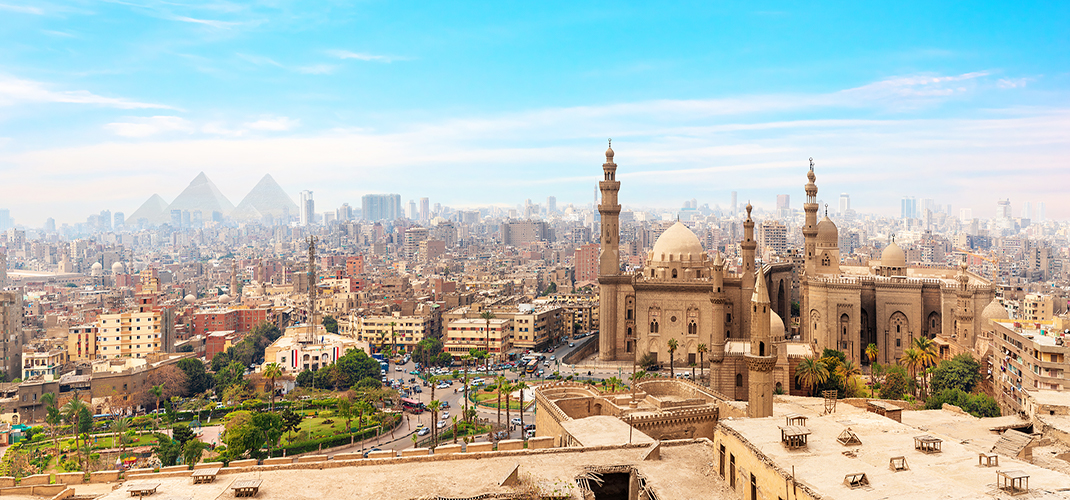Cairo

Cairo is an extremely frantic city that is beautiful and rich in history. It is a city that can easily overload your senses especially for the first time visitor. Full of energy, Cairo is where you really get a feel for Egyptian street life with tourist attractions everywhere you look, even the Giza Pyramids are located on the city’s doorstep. To get a taste of late 19th Century Cairo, take a stroll through the Downtown District where the entire area is packed full off magnificent but crumbling Belle Époque buildings. Some of the best remnants are around the Midan Talaat Harb.
Old Cairo is home to a collection of winding laneways that lie within the walls of Old Babylon, where the Roman Emperor Trajan first built a Fortress along the Nile and parts of the Roman Towers still reign over the main street. You will also find here the Coptic Museum with Egypt's finest collections of Coptic art. The 9th Century Hanging Church is next door and houses beautiful examples of Coptic architecture. The Church of St. Sergius and Bacchus is a real highlight, where local legend tells the Virgin Mary, baby Jesus, and family sheltered during King Herod's massacre of male babies. Further into the quarter, you come to the Ben Ezra Synagogue, which is said to be built near the spot where the baby Moses was found in the reeds. Just outside the quarter you can find the first ever Mosque built in Egypt, the Mosque of Amr Ibn al-As.
The Pyramids of Giza are a must-see attraction when visiting Cairo. Located on the edge of the city, you can see these the 4th Dynasty Funerary Temples. The Pyramid of Cheops, known as the Great Pyramid or Pyramid of Khufu is the largest pyramid of the Giza group. Directly behind the Great Pyramid is the Solar Boat Museum, which displays one of the ceremonial solar barques unearthed in the area that has been painstakingly restored to its original glory. Further south is the Pyramid of Chephren also known as the Pyramid of Khafre, with an internal tunnel area, which can be entered and the smaller Pyramid of Mycerinus. Guarding these Mortuary Temples is the Lion bodied and Pharaoh faced Sphinx, one of the ancient world's iconic monuments.
The Egyptian Museum houses an incredible collection of antiquities making it one of the world's greatest Museums. It currently has some empty cases due to some artefacts being transferred to the new Grand Egyptian Museum (GEM), estimated to open in the Spring of 2024. If you are short of time then head to the Tutankhamun Galleries. The treasures displayed here were all found in the Tomb of Tutankhamun, son-in-law and successor of Amenophis IV (later Akhenaten), who died at the age of 18. The Tomb was discovered in the Valley of the Kings in 1922, containing the largest and richest collection of grave goods ever found intact in any Egyptian Tomb. Highlights include Tutankhamun's Death Mask and Sarcophagi (Room 3), the Pharaoh's Lion Throne (Room 35) and his fascinating wardrobe collection (Room 9). Afterwards, stroll through the Egyptian jewellery collection (Room 4), which contains more bling than you will ever see again. Even when the GEM opens, this iconic building will still be used as a museum. It is uncertain which collections will definitely stay here and which will be transferred to the GEM once opened.
Unlike many of Cairo's other major Museums, the National Museum of Egyptian Civilisations (NMEC) is dedicated to telling the entire story of Egypt's human history under one roof. The museum partially opened in 2017 and has been slowly developing its exhibits. Its major attraction is the Royal Mummies Collection having its permanent home here. Even though the full collection is not complete you will see some of Egypt's most famous Pharaonic mummies including Ramses II and III, Hatshepsut, Amenhotep I and Seti I and II amongst the hugely familiar names of 22 mummies that are displayed in a specially designed Royal Mummies Gallery.
Saqqara and the nearby site of Dahshur are home to the other Pyramids. The sites are approximately 30 kms south of Cairo. The Step Pyramid is Saqqara's most popular tourist attraction, however the whole area is scattered with exquisitely painted Tombs.
If you like to go shopping then Khan el-Khalili or Souq Quarter is for you. This Souq ‘Bazaar’ is a complex collection of thin alleyways established as a shopping district in AD 1400, which still clangs with the sounds of metal workers and silversmiths. Here, you will find everything from antiques and elegant metal lampshades to locally woven textiles. You will find the gold and silver workshops just north of the intersection with Al-Muizz Li-Din Allah Street, while the spice markets are just to the south.
Situated right in the heart of the Islamic Cairo district is the Al-Azhar Mosque one of the finest building of Cairo's Fatimid era and one of the city's earliest surviving Mosques, completed in 972 A.D. The main entrance is the Gate of the Barbers on the northwest side of the building, adjoining the Neo-Arab façade built by Abbas II. Leave your shoes at the entrance and walk into the central courtyard where on the right side is the El-Taibarsiya Medrese, with a mihrab (prayer niche) dating back to 1309. In the central courtyard, is where you will get the best views of the Mosque's five minarets crowning the building.
Sultan Hassan Mosque is one of the finest examples of Mamluk architecture in the world. Built in 1356-63 for the Sultan Hassan el-Nasir the Mosque is a vision of Islamic artistry with an abundance of stalactite detailing and intricate Arabesque features. The massive main doorway at the north corner is almost 26 metres high and the minaret at the south corner is the tallest in Cairo at 81.5 metres. Directly facing the Sultan Hassan Mosque is the El-Rifai Mosque, built in 1912 to house the Tomb of Khedive Ismail and constructed to replicate its older neighbour. Other Mosques to visit include the Ibn Tulun Mosque and the Mosque of Al-Hakim.
The Citadel is located at the foot of the Mokattam Hills, built by Saladin in 1176. Nicknamed the Alabaster Mosque, the Mosque of Muhammad Ali is the most famous monument and main reason for visiting. Its white stone and tall, disproportionately slender minarets are one of Cairo's great landmarks. The views from the Gawhara Terrace are spectacular over the city.
